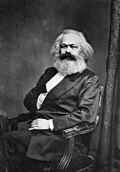
The hand-in-waistcoat (also referred to as hand-inside-vest, hand-in-jacket, hand-held-in, or hidden hand) is a gesture commonly found in portraiture during the 18th and 19th centuries, as well as mid-19th century photography. [1] The pose appeared by the 1750s to indicate leadership in a calm and firm manner. It is most often associated with Napoleon Bonaparte because it was used in several portraits made by his artist, Jacques-Louis David, amongst them the 1812 painting Napoleon in His Study . [2] The pose, thought of as being stately, was copied by other portrait painters across Europe and America. Most paintings and photographs show the right hand inserted into the waistcoat/jacket, but some sitters appear with the left hand inserted. It is also a gesture known to Freemasons. [3]



















